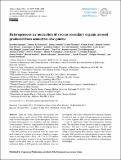Heterogeneous ice nucleation of viscous secondary organic aerosol produced from ozonolysis of α-pinene
Author(s)
Ignatius, Karoliina; Kristensen, Thomas B.; Järvinen, Emma; Nichman, Leonid; Fuchs, Claudia; Gordon, Hamish; Herenz, Paul; Hoyle, Christopher R.; Duplissy, Jonathan; Garimella, Sarvesh; Dias, Antonio; Frege, Carla; Höppel, Niko; Tröstl, Jasmin; Wagner, Robert; Yan, Chao; Amorim, Antonio; Baltensperger, Urs; Curtius, Joachim; Donahue, Neil M.; Gallagher, Martin W.; Kirkby, Jasper; Kulmala, Markku; Möhler, Ottmar; Saathoff, Harald; Schnaiter, Martin; Tomé, Antonio; Virtanen, Annele; Worsnop, Douglas; Stratmann, Frank; ... Show more Show less
DownloadIgnatius-2016-Heterogeneous ice nu.pdf (947.7Kb)
PUBLISHER_CC
Publisher with Creative Commons License
Creative Commons Attribution
Terms of use
Metadata
Show full item recordAbstract
There are strong indications that particles containing secondary organic aerosol (SOA) exhibit amorphous solid or semi-solid phase states in the atmosphere. This may facilitate heterogeneous ice nucleation and thus influence cloud properties. However, experimental ice nucleation studies of biogenic SOA are scarce. Here, we investigated the ice nucleation ability of viscous SOA particles. The SOA particles were produced from the ozone initiated oxidation of α-pinene in an aerosol chamber at temperatures in the range from −38 to −10 °C at 5–15 % relative humidity with respect to water to ensure their formation in a highly viscous phase state, i.e. semi-solid or glassy. The ice nucleation ability of SOA particles with different sizes was investigated with a new continuous flow diffusion chamber. For the first time, we observed heterogeneous ice nucleation of viscous α-pinene SOA for ice saturation ratios between 1.3 and 1.4 significantly below the homogeneous freezing limit. The maximum frozen fractions found at temperatures between −39.0 and −37.2 °C ranged from 6 to 20 % and did not depend on the particle surface area. Global modelling of monoterpene SOA particles suggests that viscous biogenic SOA particles are indeed present in regions where cirrus cloud formation takes place. Hence, they could make up an important contribution to the global ice nucleating particle budget.
Date issued
2016-05Department
Massachusetts Institute of Technology. Department of Earth, Atmospheric, and Planetary SciencesJournal
Atmospheric Chemistry and Physics
Publisher
Copernicus GmbH
Citation
Ignatius, Karoliina et al. “Heterogeneous Ice Nucleation of Viscous Secondary Organic Aerosol Produced from Ozonolysis of α-Pinene.” Atmospheric Chemistry and Physics 16.10 (2016): 6495–6509.
Version: Final published version
ISSN
1680-7324
1680-7316